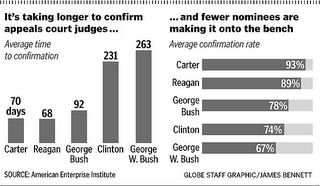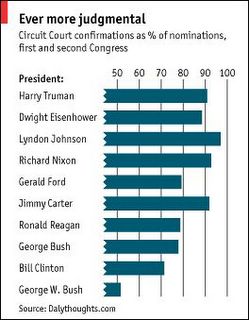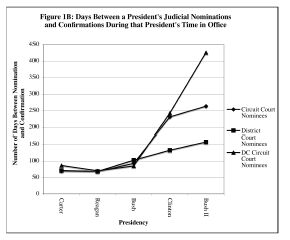My research uncovered four studies that (a) addressed the question comprehensively over a few decades; (b) cited sources for their data; and (c) employed valid methodology and statistical analysis.1 Those are:
- Congressional Research Service, RL31635 (Feb 2004) (data through year-end 2003). CRS compared Supreme Court, Court of Appeals and District Court judicial confirmation rates from Carter to Bush 41; The Economist's May 19th issue relied on CRS data. CRS also has historical data beginning in 1945.
- Department of Justice, Office of Legal Counsel (last updated May 2005), with data scattered throughout the DOJ website and mostly covers Bush's nominees, listed by each separate two-year Congress, 107th (2001-02), 108th (2003-04) and 109th (2005-). Nonetheless, DOJ does compare the success Presidents from Carter to Bush 43 during their first two years in office.
- An AEI study by conservative John Lott (data through February 2005), summarized here. Lott also listed some results on his blog.
- An analysis by Gerry Daily on his Daily Thoughts blog, which is summarized here and relied upon in this week's Economist. Gerry has further thoughts here.
With that caveat, the most significant tables and charts are below. Click to enlarge:
1) Circuit and District Court Confirmation Rates (CRS)

2) Circuit and District Court Confirmation Rates (CRS via The Economist2)

3) Circuit and District Court Confirmation Rates (first two years only) (DOJ)

4) Circuit and District Court Confirmation Rates (Lott)

5) Circuit Court Confirmation Rates (Lott)

6) Circuit Court Confirmation Rates (Daily Thoughts via The Economist)

7) Time Between Nomination and Confirmation (CRS)

8) Time Between Nomination and Confirmation (Lott)

Conclusions:
- The numbers aren't consistent between studies and data sources. A better man -- Baseball Crank perhaps? -- should reconcile the figures.
- Nevertheless, the overall trend is clear. All studies show that fewer Bush judicial nominees confirmed as compared with any recent president.
- This is particularly true for circuit court nominees, which have plummeted. Bush had more success in district court, with more confirmed nominees than Clinton (and about the same as Reagan). As Juan Non-Volokh observes, the truth is that: "President Bush has the lowest appellate nominee confirmation rate of the last three Presidents. This is even more remarkable because, of the three, President Bush has had the Senate under the control of the opposition party for the least amount of time."
- For confirmed judges, the time between nomination and confirmation is longer than any recent president.
- Gerry Daily's right:
[I]t is clear that [appellate court nominations] have been on a downhill trend since the Carter Presidency. Reagan’s confirmation percentage, while still above 80%, was about 10 points lower than Carter’s, and the off all of the previous Presidents’. George H.W. Bush’s Presidency was the first time the confirmation percentage dropped below 80%. Clinton’s was the first time it dropped below 70%. And George W. Bush’s is the first time it has dropped below 60%.
- Correlation isn't causation--but it sure is suspicious.
____________________
1 The Library of Congress on-line database is accurate but unhelpful--it bundles judicial with other presidential appointments.
2 The columns are misalligned (in all but the first year of each presidential term) in the original.
3 comments:
Nice summary of the evidence. Thanks!
However, I'd add that the problem appears to be a bi-partisan decline in Senate comity. Is restoring the "consititutional option" really a solution?
I thought I had pointed that out to you a while ago (the greater trend).
I think one of the bigger issues that that the is much less consulting of the senate (both parties) prior to nominating a judge. Usually this was hashed out prior to the nominations being made.
Dingo:
My thoughts here.
Post a Comment